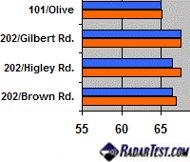Article from: www.thenewspaper.com/news/28/2866.asp
8/12/2009
Arizona: Independent Test Shows Speed Cameras Do Not Slow Drivers
Independent measurement shows that speed cameras have no effect on Arizona highway speeds.
 The state of Arizona began deploying speed cameras on freeways last year for the stated purpose of slowing drivers. Scottsdale was the first jurisdiction in the state to use such cameras and issued $17 million worth of automated freeway tickets before the state took over the program. The city paid a local professor $75,000 to create a study to show that drivers had slowed. An expert in radar technology produced a report last month insisting that is not the case.
The state of Arizona began deploying speed cameras on freeways last year for the stated purpose of slowing drivers. Scottsdale was the first jurisdiction in the state to use such cameras and issued $17 million worth of automated freeway tickets before the state took over the program. The city paid a local professor $75,000 to create a study to show that drivers had slowed. An expert in radar technology produced a report last month insisting that is not the case.
Craig Peterson is the founder of RadarTest.com, a company that has performed independent evaluations of various types of radar and laser speed detection equipment for nearly two decades. Peterson performed an independent and simple test of Arizona's photo radar program to verify whether drivers have actually slowed.
"Accurate statistics of accidents at camera locations won't be available for some time yet, but now that scores of speed cameras and a fleet of 100 photo radar vans have been deployed, it certainly isn't difficult to measure the cameras' effect on freeway speeds," Peterson explained.
Peterson set up his equipment on freeways in Glendale, Mesa, Prescott Valley and Star Valley. He used a Kustom Signals Pro Laser III lidar gun and LaserStat traffic survey software to measure speeds one-half mile before a speed camera and one-half mile after the camera during free-flow traffic. The sample included at least 200 measurements at each location using the speeds of cars in each travel lane. In all cases, Peterson strictly adhered to accepted engineering practices for performing a traffic speed study.
"Interestingly, the numbers from every site were nearly identical," Peterson wrote. "Far from slowing traffic, the cameras had no effect on freeway speeds... Aside from a brief dab at the brakes by a few drivers in reaction to fixed speed cameras -- frequently resulting in screeching tires from cars behind -- most seemed oblivious to them. Hardly any slowed in reaction to the speed vans."
The speed limit on the Loop 101 freeway is 65 MPH, although engineering guidelines suggest that limits be set at the 85th percentile speeds, the rate at which the vast majority of motorists safely travel. Peterson's measurements found that the 85th percentile speed on the Loop 101 ranged from 70 MPH to 73.4 MPH at the original photo radar locations in Scottsdale. Before and after speeds were identical except by a statistically insignificant increase in the after speed at two locations.
The National Motorists Association, which opposes the use of speed cameras, was not surprised by the findings.
"Believing the claims of companies that sell photo enforcement equipment or municipalities that use this equipment is like believing any commercial produced by a company that is trying to sell you something," the group explained on its website. "There is no independent verification that photo enforcement devices improve highway safety, reduce overall accidents, or improve traffic flow."
Source: Are Speed Cameras Effective? (RadarTest.com, 7/8/2009)
Permanent Link for this item
Return to Front Page
 The state of Arizona began deploying speed cameras on freeways last year for the stated purpose of slowing drivers. Scottsdale was the first jurisdiction in the state to use such cameras and issued $17 million worth of automated freeway tickets before the state took over the program. The city paid a local professor $75,000 to create a study to show that drivers had slowed. An expert in radar technology produced a report last month insisting that is not the case.
The state of Arizona began deploying speed cameras on freeways last year for the stated purpose of slowing drivers. Scottsdale was the first jurisdiction in the state to use such cameras and issued $17 million worth of automated freeway tickets before the state took over the program. The city paid a local professor $75,000 to create a study to show that drivers had slowed. An expert in radar technology produced a report last month insisting that is not the case.